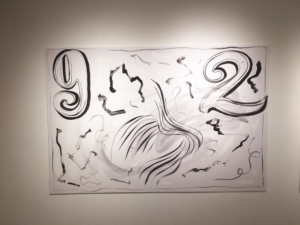 By Amanda Romeo
By Amanda Romeo
Hofstra art students gathered at the Rosenberg Gallery in Calkins Hall for the opening reception of the exhibit “Privacy” this past Wednesday.
“Privacy” is a series of contemporary paintings by renowned artist Henning Strassburger. Thanks to Jim Lee from the Fine Arts department, Strassburger made an appearance at the opening of his exhibit, giving students an opportunity to meet with the artist and ask him questions about his work and his process.
Strassburger is known professionally around the world for his expressionism and abstract conceptual art. Originally from Germany, he has been studying and creating art since he was just 13 years old.
Strassburger says he has known he was an artist ever since he was young. His art was initially based in Berlin, but today Henning Strassburger has been represented in exhibitions across the globe, including some of the largest galleries in the world.
As a contemporary artist, he explores the idea of what it means to create art in modern day society – where imagery is highly prominent and increasingly digital. Strassburger’s art invites viewers to open their eyes as well as their mind, as his work is often highly conceptual and abstract.
In “Privacy,” Strassburger draws on the concepts of money and currency. He uses multiple layers of paint to make his every stroke apparent to the viewer, mimicking the intimacy involved in the creation of money.
“Money is hand drawn,” as Strassburger explained. “When you look at it through a microscope, you can see the hand of the artist.” The distinct brush strokes and added texture in the paintings imitate this concept on a larger scale. Strassburger says his intention was to make his entire process visible, which is evident in his pieces.
All the paintings are done entirely in different shades of black and white. Many of the larger pieces have lightly painted, uneven gray boarders.
Large, boldly displayed numbers immediately capture the eye of the viewer in every piece, while rhythmic use of line repetition guides the eye smoothly across each painting.
The style in which the exhibit is presented is certainly something to ponder. All of the paintings were done in many layers and on foam presentation boards – not the typical canvas. Strassburger’s decision to use presentation boards as opposed to more practical canvas makes a subtle statement about absurdity, rendering an art exhibit similar to something of a business presentation.
Another way Strassburger highlights absurdity in “Privacy” is by incorporating numbers that are of unorthodox value for currency.
One of the smaller pieces in particular stands out as one of the most absurd. With a large 51 in the upper right-hand corner, the piece has an image of an eyeball in the center, similar to the way American bills have the faces of founding fathers on them.
Strassburger spoke to students about his inspiration for “Privacy,” and how the concept behind it defines what it means to be a contemporary artist. “I try to be a contemporary man,” Strassburger told students, “I don’t know what bitcoin is but it is all over the newspapers … so [currency] is sort of an abstract thing.”
What many students found interesting were the artist’s thoughts on making mistakes. He said, “I chose this material and every wrong move will be shown.” Many students found it refreshing to hear a successful artist tell them to embrace their mistakes rather than reject them.
To explain this, Strassburger compared the artistic process to the process of thinking, and said, “once you think something, that’s it, you can’t take it back.”
Speaking more about his process, he explained that certain works, like “Privacy,” are a “one-shot process,” meaning that any flaws will end up a part of the final product.
Strassburger believes that error is an important part of the development of art. He compared it to Charles Green’s idea of “the third hand,” saying failure is not something one can rely on as an artist, but should still embrace.


